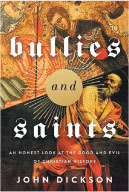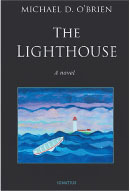Art by Christine Cole; Signs of Life (McAlpine, Thiessen, Walker); Bullies and Saints (Dickson); The Lighthouse: A Novel (O'Brien); Forming Christian Communities in a Secular Age (Dickau); Five Little Indians (Good)
Signs of Life: Catholic, Mainline, and Conservative Protestant Congregations in Canada
By Bill McAlpine, Joel Thiessen, Keith Walker and Arch Chee Wong
Tyndale Academic Press, 2021. 262 pages. $25 (e-book $20)
WHAT MAKES for a flourishing congregation? That is the key question in this fresh discussion starter on church life in Canada. The book draws from surveys and interviews of professional and lay leaders in congregations across Canada’s geography and Christian theological spectrum (except, unfortunately, Orthodox).
The authors examine 11 categories of congregational life – self-identity, leadership, innovation, structures and processes, discipleship, engaged laity, hospitality, diversity, neighbourhood involvement, partnerships and evangelism.
This schema is perhaps the greatest gift of the book. It broadens the discussion of success beyond the typical preoccupation with membership statistics by also paying attention to congregations’ social contexts and identities (denominational or otherwise). Diversity, collaborative leadership and community partnerships, for example, can be signs of flourishing. Evangelism, the book acknowledges, is understood differently by various traditions – and that should be respected.
The authors, affiliated with the Flourishing Congregations Institute founded at Ambrose University in 2016, also are quick to acknowledge the limitations of their research. Interviewees, for example, are overwhelmingly male (as are the authors). Indigenous and immigrant voices are under-represented. U.S. research is often invoked when Canadian data is lacking. Even so, the authors use both the gaps and their findings to stimulate conversation, self-reflection and articulation of vision.
This is an excellent resource for leaders looking to renew their witness and community life. And look for other new resources at www.FlourishingCongregations.org. – BYRON REMPEL-BURKHOLDER
Join us at the EFC Virtual Book Club’s discussion of Signs of Life on Nov. 18. Order the book from your local bookstore and register at www.TheEFC.ca/BookClub.

Bullies and Saints: An Honest Look at the Good and Evil of Christian History
By John Dickson
Zondervan, 2021. 352 pages. $24 (e-book $12.99, audiobook $37)
THIS BOOK bids us take a long, hard look at how Christian history includes evil and error.
Historian John Dickson, an Australian, presents a straightforward thesis. In His earthly life Jesus taught His followers a beautiful anthem of love and compassion that we are to continue and amplify.
Through the centuries the Church has sung His song in acts of mercy, generosity and self-sacrifice. Yet just as often we have botched the music and even abandoned it for strident chords of suspicion, hatred and oppression.
Dickson’s volume is not a comprehensive primer on Church history. Still, it introduces us to many of the key players – bullies and saints – whose choices have shaped our story. The author rejects simplistic explanations for the Church’s lapses into aggression. Rather he draws attention to the complexities of historical context, and to the ways the world was being converted to the Church – and regrettably, the Church to the world.
He highlights the great irony of how campaigns of bullying and charity frequently unfold simultaneously – and how hostility and compassion often flow from the same individuals and institutions.
This honest and insightful study is a timely call to personal reflection. Are we – am I – being faithful to Christ’s song? –EVELYN PEDERSEN

The Lighthouse: A Novel
By Michael D. O’Brien
Ignatius Press, 2020. 215 pages. $25 (e-book $14, audiobook $21)
AN 18-YEAR-OLD comes to a lighthouse off Cape Breton Island to help the aged keeper. The younger man’s quiet and attentive nature adapts well to keeping the light burning, and he falls in love with the solitary life at the edge of the sea.
"The intoxicating aroma of crushed bayberry leaves" and "the perfume of bonfires he made from driftwood" and the "salt scent borne to him across thousands of miles of ocean" soothe and heal childhood wounds of neglect and abuse.
He gets hired and stays on, taking few trips into town for mail and supplies. There he engages in only the most necessary interactions. No wonder he views visitors to his rocky home with a jaundiced eye.
They do come, however, out of simple curiosity, or with an attitude of obnoxious entitlement, or seemingly guided by an unseen providence, bringing an aura of truth and beauty that awakens within Ethan trust, hope and a sense of "Someone good, someone with me. … It’s like an awakeness in the world."
The book is beautifully written with rich passages describing nature and Ethan McQuarry’s simple lifestyle. Themes of identity, purpose, isolation, family and trust are fleshed out during his forays into Brendan’s Harbour and the few close relationships he forms.
Pervading it all is the sense none of this is mere happenstance. Like the lighthouse faithfully casts its beams across the waves, so there is a someone, an awakeness that sees and faithfully guides each step, each relationship of Ethan’s and, by implication, ours. –VIOLET NESDOLY
 ARTWORK © AMANDA LE BLANC
ARTWORK © AMANDA LE BLANC
Forming Christian Communities in a Secular Age: Recovering Humility and Hope
By Tim Dickau
Tyndale Academic Press, 2021. 210 pages. $25 (e-book $20)
THIS BOOK has two concerns – understanding the impact of our secular culture on the Church and responding to this theology in real life.
It’s a must read for church leaders, deeply thought out with examples of application that make the heavy theological discussion parts worthwhile.
Author Tim Dickau of the Centre for Missional Leadership at St. Andrew’s Hall in Vancouver draws on the insightful 2007 book A Secular Age by Canadian philosopher Charles Taylor. Dickau encourages us to work through the philosophy because his practical applications (often drawn from his experiences at Grandview Church in Vancouver) will help it all make sense.
This book shows why deep theological thinking and reflection are important, and how they have direct impact. It calls churches to practices that enact a gospel-centric culture through life lived in close proximity and through social action.
These ideas revolutionized Grandview Church. You’ll come away thinking, "If they did it, so can we." –NATHAN SCOTT
READING THE BESTSELLERS
Five Little Indians
By Michelle Good
HarperCollins, 2020. 304 pages. $23 (e-book $14, audiobook $34)
THIS GUT-WRENCHING READ is rightly scooping up writing awards such as the Governor General’s Literary Award for Fiction and the Amazon First Novel Award. It was a finalist for the Scotiabank Giller Prize.
The novel tells the stories of Kenny, Lucy, Clara, Howie and Maisie, First Nations children removed from their homes and communities and placed in Canada’s residential school system. Downtown Eastside Vancouver, one of Canada’s hardest neighbourhoods, features in the debut novel as well, as the place the teens struggle to make their home in the 1960s.
Finally released from the residential schools, they are each set adrift into a society steeped in racism. They face discrimination at almost every turn. They also find each other, friends, enemies and eventually most find some kind of solace and new beginnings.
But these are hard streets they live on, and this is a hard but ultimately redemptive read, as the youth grapple with the severe damage done to them by the residential school system. It is easy to understand the generational trauma of residential schools from the stories on these pages.
Some scenes will shock sensitive readers who might not typically read gritty, painful novels. There are scenes of sexual violence.
This novel was part of my own reading quest to understand better the residential school system. Fiction is a fine teacher, and Five Little Indians does its job well, carrying the reader into the heart of five survivors where we sit beside them in their pain and their resiliency and understand better this awful part of Canada’s history. –KAREN STILLER
CANADIAN CREATIVES

Don’t go there. (chalk pastel, 10″ × 10″) by Amanda Le Blanc. amandaleblanc.wixsite.com/portfolio and instagram.com/lucidpalette
"My artwork uses symbolism to convey meaning. Here I use a snake and a lightbulb to talk about fear. Black mambas are one of the world’s deadliest snakes. Their venom causes paralysis, has adverse effects on the heart and can kill quickly. Fear is like this too – though it may not kill you, it can kill your dreams. Mountains of opportunity can look more like teeth warning us to stay put and settle. If we give in, we can end up living in a desert of complacency. It’s okay to be afraid but, if we weren’t afraid, what would we do? Why not do it anyways? Jesus never promised us life would be safe."
READING THE BESTSELLERS

Five Little Indians
By Michelle Good
HarperCollins, 2020. 304 pages. $23 (e-book $14, audiobook $34)
THIS GUT-WRENCHING READ is rightly scooping up writing awards such as the Governor General’s Literary Award for Fiction and the Amazon First Novel Award. It was a finalist for the Scotiabank Giller Prize.
The novel tells the stories of Kenny, Lucy, Clara, Howie and Maisie, First Nations children removed from their homes and communities and placed in Canada’s residential school system. Downtown Eastside Vancouver, one of Canada’s hardest neighbourhoods, features in the debut novel as well, as the place the teens struggle to make their home in the 1960s.
Finally released from the residential schools, they are each set adrift into a society steeped in racism. They face discrimination at almost every turn. They also find each other, friends, enemies and eventually most find some kind of solace and new beginnings.
But these are hard streets they live on, and this is a hard but ultimately redemptive read, as the youth grapple with the severe damage done to them by the residential school system. It is easy to understand the generational trauma of residential schools from the stories on these pages.
Some scenes will shock sensitive readers who might not typically read gritty, painful novels. There are scenes of sexual violence.
This novel was part of my own reading quest to understand better the residential school system. Fiction is a fine teacher, and Five Little Indians does its job well, carrying the reader into the heart of five survivors where we sit beside them in their pain and their resiliency and understand better this awful part of Canada’s history. –KAREN STILLER
Editor’s note: Faith Today earns a small commission when people make purchases using our links to Amazon.ca.